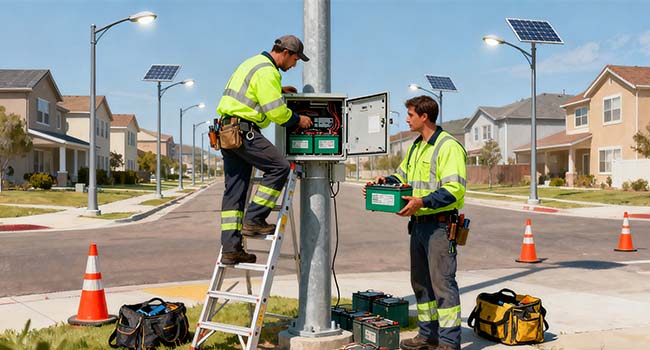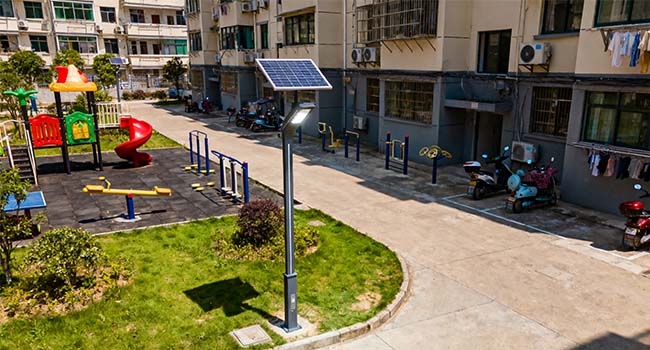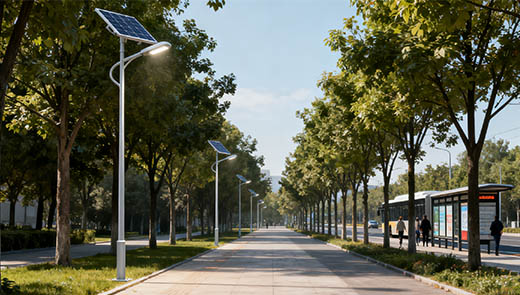Solar Street Light Battery Replacements: Enhanced Performance
In solar street light systems, batteries serve as the critical energy storage and release components, with their performance directly impacting the lighting effectiveness and operational lifespan of the street lights. As usage and environmental conditions evolve, battery replacement becomes an essential measure to ensure stable street light operation, making scientific selection and timely replacement crucial.

Understanding the Role of Batteries in Solar Street Lights
In solar street light systems, batteries serve as the irreplaceable “energy storage hub,” with their operational status directly determining the overall efficiency of the lights. During daylight hours, solar panels convert sunlight into electricity, which must be efficiently stored by the battery to prevent energy loss. At night, the battery must steadily release stored energy to continuously power the LED light source, ensuring the street light illuminates for its designed duration. Should battery performance degrade or fail, even with fully functional solar panels and controllers, the streetlight will exhibit reduced illumination duration, diminished brightness, or complete failure. Therefore, battery maintenance and timely replacement are core elements in ensuring the long-term, stable operation of solar street lights.
Types of Solar Street Light Batteries
Different types of solar street light batteries exhibit significant differences in energy density, lifespan, cost, and environmental adaptability. Selecting the appropriate battery type is fundamental to enhancing street light performance. Below is a detailed analysis of four mainstream batteries based on core characteristics and applicable scenarios:
Lithium-ion (Li-ion) Batteries
Lithium-ion batteries have become the mainstream choice for solar street lights due to their outstanding overall performance. Their core advantage lies in high energy density: for the same capacity, they occupy only one-third the volume and weigh just one-fifth of lead-acid batteries. This significantly saves space in the light's battery compartment while reducing installation and handling difficulties. With a cycle life of 800-1200 cycles, corresponding to an actual service life of 8-10 years, they far exceed traditional lead-acid batteries. They also exhibit excellent high and low temperature adaptability, maintaining stable charging and discharging performance in environments ranging from -20°C to 60°C. No additional temperature control equipment is required, resulting in extremely low maintenance needs.
However, lithium-ion batteries carry a relatively higher initial purchase cost. Over the long term, their extended lifespan and low maintenance requirements significantly reduce total operational costs. This makes them more suitable for scenarios demanding high performance and limited installation space, such as streetlights along urban thoroughfares, commercial districts, and industrial parks.
Lead-Acid Batteries
Lead-acid batteries (also known as VRLA or AGM batteries) represent an earlier battery type in solar street lighting applications. Their core advantage lies in low cost—priced at approximately one-third of lithium-ion batteries for equivalent capacity—and stable voltage output, enabling continuous power supply for low-power LED light sources. Consequently, they remain applicable in budget-constrained scenarios.
However, lead-acid batteries have notable drawbacks. Their low energy density results in bulky, heavy units that occupy more installation space and increase load pressure on solar light poles. With a cycle life of only 300-500 cycles, they typically require replacement after 3-5 years of use—significantly more frequent than lithium-ion batteries. Additionally, they are sensitive to ambient temperature: capacity drops by over 30% below -10°C, and frequent maintenance is required in high-temperature environments (e.g., checking electrolyte levels, cleaning terminals). Consequently, they are better suited for scenarios like rural roads or temporary construction sites where lighting duration and performance requirements are lower, and regular maintenance is feasible.
GEL Batteries
GEL batteries represent an enhanced version of lead-acid technology. By adding gelling agents to the sulfuric acid electrolyte, the electrolyte achieves a gel-like state. This innovation eliminates the frequent maintenance required by traditional lead-acid batteries, making GEL batteries completely maintenance-free. Compared to traditional lead-acid batteries, GEL batteries offer a 20%-30% increase in energy storage capacity and discharge efficiency. They achieve a cycle life of 500-800 cycles, translating to 5-8 years of practical use, and exhibit excellent shock resistance, making them suitable for installations in environments with vibrations and jolts. However, GEL batteries are significantly more expensive than traditional lead-acid batteries, with some high-capacity models approaching the cost of lithium-ion batteries. Therefore, they are better suited for scenarios with large temperature variations, frequent vibrations, or high maintenance difficulty, such as streetlights in mountainous roads, coastal areas, and remote rural regions.
Ternary Lithium Batteries
Ternary lithium batteries offer unique low-temperature adaptability, maintaining over 80% capacity at -30°C. They deliver stable charge/discharge efficiency, high energy density, and rapid charging—reaching full capacity in 3-4 hours. Compact and lightweight, they seamlessly integrate into both integrated and split-type solar street lights. Their cycle life reaches 800-1000 cycles, translating to 6-8 years of practical use, with distinct advantages in northern regions with low temperatures.
However, ternary lithium batteries exhibit poor high-temperature stability, with internal structures becoming unstable above 60°C. Products from non-certified manufacturers may pose safety risks during overcharging or high-temperature exposure. Additionally, their higher cost compared to traditional lead-acid batteries makes them primarily suitable for cold northern regions or integrated solar street light installations with strict space constraints.

How Common Are Solar Street Light Battery Replacements?
Battery type fundamentally determines replacement cycles: lithium-ion batteries last 8-10 years, while lead-acid batteries only 3-5 years—the former requiring replacement just one-third as often as the latter. External environments significantly impact battery longevity. High temperatures accelerate internal chemical reactions, causing electrolyte evaporation—lead-acid batteries lose 40% lifespan above 40°C. Low temperatures reduce capacity, while ternary lithium batteries degrade below -40°C. High humidity may corrode battery terminals, further hastening deterioration.
Usage and maintenance habits are equally critical. If street lights operate daily beyond their design duration (e.g., 12 hours instead of the designed 8 hours), it increases the battery's cycling load and shortens its lifespan. Conversely, regular maintenance—such as cleaning solar panels (to prevent shading and ensure efficient charging), inspecting battery terminals, and removing dust from battery compartments—can extend battery life by 1-2 years. Additionally, installation quality is paramount. Loose battery connections or inadequate waterproofing can cause abnormal charging/discharging cycles or even short circuits, necessitating premature battery replacement.
What Warrants a Solar Street Light Battery Replacement?
Insufficient Capacity
If a solar street light's nighttime illumination time significantly falls below design standards after adequate daytime charging—e.g., dropping from 10 hours to under 5 hours—and this persists for multiple consecutive days, it indicates battery capacity degradation after ruling out panel shading or controller parameter errors. This occurs because prolonged charge-discharge cycles cause internal electrodes to degrade, reducing storage capacity. The battery can no longer hold sufficient energy for nighttime illumination. Continued use not only compromises lighting performance but risks permanent damage from over-discharge.
Diminished Performance
Abnormal brightness is a direct indicator of battery degradation, primarily manifesting in two scenarios:
First, if the streetlight brightness noticeably dims—for example, dropping from a design value of 500lm to below 200lm—while daytime sunlight remains normal, this indicates the battery cannot supply sufficient voltage to the light source, resulting in reduced light output.
Second, the streetlight may fail to illuminate entirely. However, if a multimeter confirms the solar panel is generating power normally (voltage ≥18V) and the controller indicator lights display correctly (no fault codes), this indicates the battery has completely lost its charge/discharge capability and cannot release energy. Both scenarios signify severe battery degradation. Continued use will render the streetlight incapable of meeting lighting requirements, necessitating immediate replacement.
Visible Physical Damage
Visible physical damage to the battery not only compromises performance but also poses safety risks, necessitating immediate replacement. Common signs include: swollen or cracked battery casing, electrolyte leakage from terminals, and corrosion on the casing. Such damage directly causes battery failure. Leakage and swelling may trigger short circuits or fires, endangering the streetlight system and surrounding environment. Therefore, upon detecting any visible damage, the solar streetlight must be decommissioned immediately and the battery replaced.
Incompatibility with System Upgrades
As lighting requirements evolve, some solar street lights undergo system upgrades, such as replacing lower-wattage LED light sources (e.g., upgrading from 30W to 60W) or adding smart controllers (enabling remote dimming and fault alerts). In such cases, the original battery may become incompatible with the new system due to mismatched voltage or capacity. For instance, a 12V 100Ah lead-acid battery in the original system paired with a 30W light source could provide 10 hours of illumination. Upgrading to a 60W light source would reduce the battery's runtime to just 5 hours, and the 12V voltage may fail to meet the new controller's power requirements.
Similarly, when switching from lead-acid to lithium-ion batteries, mismatched charge/discharge protection parameters (e.g., lead-acid overcharge voltage 13.8V vs. lithium-ion 14.4V) can cause overcharging or undercharging of lithium-ion cells. In such cases, batteries must be replaced with models compatible with the new system's voltage and power requirements to ensure proper operation.

Inadequate Maintenance
If solar street lights lack long-term maintenance—such as severe dust accumulation on solar panels, neglected cleaning of battery terminals, or untreated water ingress in battery compartments—battery lifespan will significantly shorten even without apparent failure. Such batteries may not have reached their design lifespan but exhibit irreversible internal degradation. Continued use risks sudden failure. Therefore, it is recommended to replace batteries proactively at 70%-80% of their service life (e.g., 2-3 years for lead-acid batteries, 5-6 years for lithium-ion batteries), considering maintenance conditions. This prevents light outages due to battery failure and avoids increased emergency maintenance costs.
Battery Replacement Options for Solar Street Lights
Upgrading to Advanced Battery Technology
If the original street light uses lead-acid or GEL batteries, upgrading to lithium-ion batteries is recommended during replacement to enhance performance through technological advancement. Lithium-ion batteries achieve charge/discharge efficiency exceeding 90%, surpassing lead-acid batteries (70%-80%) by 10%-20%. They fully recharge in just 3-4 hours during daylight, ensuring basic nighttime illumination even on cloudy days and significantly improving resistance to overcast/rainy conditions.
Lithium-ion batteries last 2-3 times longer than lead-acid batteries, reducing replacement frequency and labor costs. Their compact size and lightweight design accommodate more streamlined streetlight configurations, even supporting integrated installations. This reduces load on light poles and simplifies installation.
Compatibility with Existing Systems
Before battery replacement, thoroughly evaluate existing system parameters to ensure full compatibility between the new battery, controller, light source, and battery compartment, preventing installation or operational failures. First, verify electrical parameter matching: the new battery's voltage must align with the original system, and its capacity should be calculated based on light source power and designed illumination duration.
Finally, controller parameter debugging is essential. When switching from lead-acid to lithium-ion batteries, adjust the controller's charge/discharge protection voltages (lithium-ion overcharge protection: 14.4V, undercharge protection: 10.8V; compared to 13.8V and 10.5V for lead-acid batteries). If the controller does not support parameter adjustment, it must be replaced with one compatible with lithium-ion batteries to prevent damage from overcharging or undercharging.
The long-term stable operation and performance of solar street lights fundamentally depend on battery condition. A scientifically sound battery replacement strategy is key to resolving lighting failures and enhancing system efficiency. By selecting compatible battery types, promptly identifying replacement signals, and ensuring post-replacement system compatibility, you can not only swiftly resolve streetlight illumination issues but also significantly extend the overall lifespan of the streetlights while reducing long-term operational and maintenance costs.




